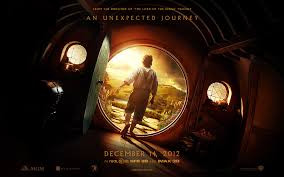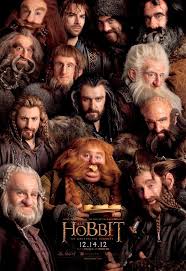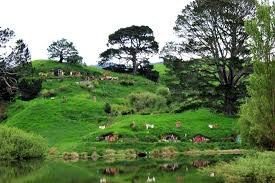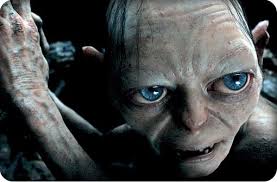 I actually saw The Hobbit (part 1) while it was still on its first run (thanks, friend Linda). The defining word for the film? Action. All over, all the time. I got a bit worn out with some of the hyper-extended chases, escapes, and battles. The scene of escape from the caves had at least six times when you thought Gandalf and the dwarfs were out, only to have some additional peril appear.
I actually saw The Hobbit (part 1) while it was still on its first run (thanks, friend Linda). The defining word for the film? Action. All over, all the time. I got a bit worn out with some of the hyper-extended chases, escapes, and battles. The scene of escape from the caves had at least six times when you thought Gandalf and the dwarfs were out, only to have some additional peril appear.
 Then there were the thirteen dwarfs. Yes, the make-up geniuses Jackson works with did make each one look distinctly different from the others. But why? They functioned as a sort of belching and farting Greek chorus, almost always acting together as a clump. A running (and telling) gag was Gandalf counting the dwarfs after each battle “ten…eleven…twelve…” He didn’t call them by name. Who could? (OK, Jake Shapiro probably could.) I hope that over the course of parts 2 and 3, the dwarfs will differentiate in a meaningful (not just cosmetic) way.
Then there were the thirteen dwarfs. Yes, the make-up geniuses Jackson works with did make each one look distinctly different from the others. But why? They functioned as a sort of belching and farting Greek chorus, almost always acting together as a clump. A running (and telling) gag was Gandalf counting the dwarfs after each battle “ten…eleven…twelve…” He didn’t call them by name. Who could? (OK, Jake Shapiro probably could.) I hope that over the course of parts 2 and 3, the dwarfs will differentiate in a meaningful (not just cosmetic) way.
That’s about it for criticism, though.
 The movie had several saving graces. The primary one was the spectacular film-making--whether it was soaring and majestic aerial shots or painstakingly real filming of miniatures. The movie is gorgeous, wonderfully lit and put together, seamless. Seamlessness is important because I know (from watching hours of extras on the extended version DVDs) that Jackson’s movies are a collage of live action filming, miniatures, computer-generated effects, maquettes, puppets, and motion-capture. The blend is superb. Even my awareness of Jackson’s techniques did not detract. The Hobbit is, indeed, a coherent visual and textural world.
The movie had several saving graces. The primary one was the spectacular film-making--whether it was soaring and majestic aerial shots or painstakingly real filming of miniatures. The movie is gorgeous, wonderfully lit and put together, seamless. Seamlessness is important because I know (from watching hours of extras on the extended version DVDs) that Jackson’s movies are a collage of live action filming, miniatures, computer-generated effects, maquettes, puppets, and motion-capture. The blend is superb. Even my awareness of Jackson’s techniques did not detract. The Hobbit is, indeed, a coherent visual and textural world.
 An equally primary saving grace is Martin Freeman as Bilbo--an inspired choice. Freeman underacts Bilbo, making him a foil for the gauchery of the dwarfs. He plays us, places us in the action. His hesitancy is our hesitancy, which makes his bravery also our bravery. Freeman is not derivative of any previous Hobbit character, but plays Bilbo fresh and strong. I can’t wait to see him in the next two parts of the story.
An equally primary saving grace is Martin Freeman as Bilbo--an inspired choice. Freeman underacts Bilbo, making him a foil for the gauchery of the dwarfs. He plays us, places us in the action. His hesitancy is our hesitancy, which makes his bravery also our bravery. Freeman is not derivative of any previous Hobbit character, but plays Bilbo fresh and strong. I can’t wait to see him in the next two parts of the story.
A third grace is the development (backwards!) and presentation of Gollum. He is the other side of Bilbo--the other character that we relate to. Bilbo is that part of ourselves we are proud of; Gollum is who we all worry that we might be. The fact that there’s a strong measure of Gollum in all of us makes this character powerful and compelling. And the combination of puppetry, cgi, motion capture and actual acting (thank you, Mr. Sirkis) is amazing--and invisible. Gollum is authentic as a living being.
 Gandalf was a bit muggy, repeating almost exactly certain facial expressions used in the LOTR movies. He is used a bit much in this film I seem to recall from the book that he was somewhat absent. I compared him to Aslan, who is more present as an idea in the Chronicles of Narnia than as an actual character.
Gandalf was a bit muggy, repeating almost exactly certain facial expressions used in the LOTR movies. He is used a bit much in this film I seem to recall from the book that he was somewhat absent. I compared him to Aslan, who is more present as an idea in the Chronicles of Narnia than as an actual character.
And Galadriel makes an appearance. Nicely done. I believed in her, added a scene with her into my memories of the book.
So, this was a great movie. My only problem was with the relentless pace of the action. I needed a few more platforms to rest upon. When (not if) I see The Hobbit again, I’ll see how it feels. I’ll be able to relax a bit more and trust my filmmaker. Thank you, Mr. Jackson, for another beautiful film.

I agree with you about the action sequences, but I didn't think there was anything wrong with Gollum's scene! I thought there were much more egregious references to LotR, most notably when Gandalf strikes the famous "You shall not pass" pose during the troll scene.
ReplyDeleteI loved the Gollum scene. And the You shall not pass did not escape me. What did you think about the baker's dozen of dwarfs.
Delete